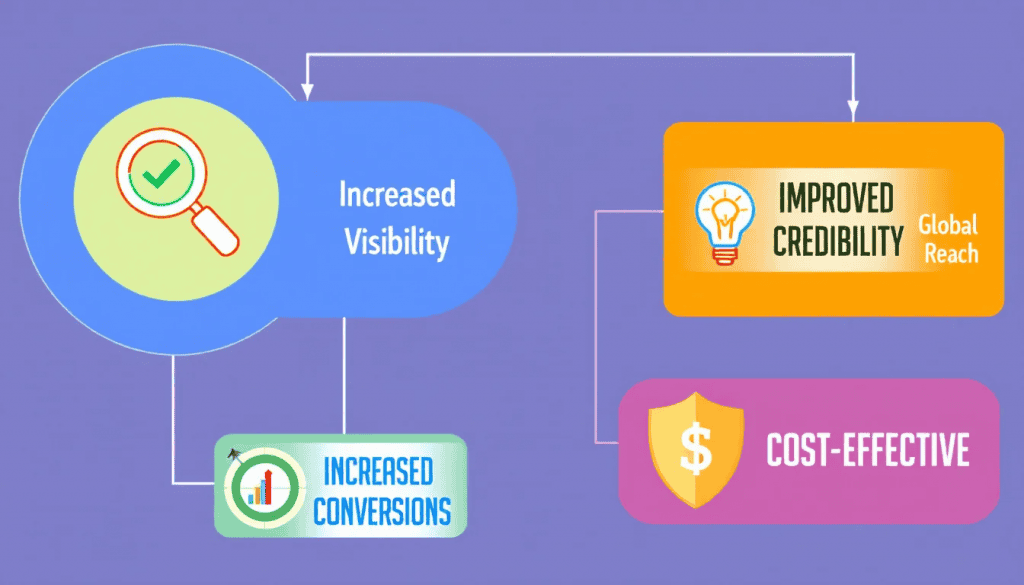Is Search Engine Marketing (SEM) the right choice for your business? This guide will walk you through the main advantages and disadvantages of search engine marketing, providing insights to help you make an informed decision. You’ll learn about both the immediate benefits and potential drawbacks of SEM, ensuring you’re well-prepared to leverage this powerful tool.
The Definitive Guide to the Advantages and Disadvantages of Search Engine Marketing

Greetings! You’ve arrived at the ultimate resource for understanding the pros and cons of Search Engine Marketing (SEM). If you’re a small enterprise endeavoring to amplify your digital footprint or an experienced marketing professional keen on refining your tactics, this guide is brimming with crucial knowledge about SEM.
We will delve into all aspects, from its direct advantages to possible challenges, empowering you to wield this formidable marketing instrument assuredly.
Introduction
For enterprises, it is crucial to hone their skills in Search Engine Marketing (SEM) to ensure that they are judiciously allocating their marketing budget and synchronizing with overarching objectives. Considering the fact that approximately 90% of consumers utilize search engines as a research tool for products and services prior to purchasing, proficient SEM has the potential to significantly sway consumer choices and bolster business expansion.
On the other hand, small business proprietors may find themselves daunted by the vast array of marketing alternatives at their disposal, which can impede crafting an efficacious strategy. It’s imperative for businesses to set clear benchmarks pertaining to brand recognition, augmenting website traffic, sales incrementation, and lead acquisition while devising a concentrated marketing approach geared towards tangible outcomes.
What is Search Engine Marketing (SEM)?
Search engine marketing (SEM) is employed to improve the visibility of a website on search engine results pages through paid advertising. It differs from organic search engine optimization, which can be slower to impact visibility. SEM offers immediate exposure and enables businesses to rapidly capture consumer interest.
The potential ROI for SEM campaigns adds to its appeal. For every dollar spent on search engine advertising, businesses typically see about a two-dollar return. This demonstrates how effective it is in driving traffic and generating leads. With the ability for companies to manage their advertising expenditure flexibly without strict minimum requirements, even smaller firms find SEM an accessible avenue for promotion.
Nevertheless, orchestrating successful SEM campaigns involves substantial time and effort and could become overwhelming without expert assistance. The evidence of Google Ads’ earnings reaching nearly $224.47 billion from search engine marketing in 2022 underscores its significance as a lucrative but complex component of digital strategy that necessitates meticulous oversight for optimal performance.
Key Advantages of Search Engine Marketing

Search Engine Marketing (SEM) provides an array of advantages for businesses aiming to strengthen their online visibility and garner swift outcomes. SEM’s benefits comprise:
- Prompt visibility
- Precision-targeted advertising
- Quantifiable results
- Improved brand recognition
SEM serves as a powerful tool in propelling website traffic and fostering lead generation.
Delving into these principal benefits reveals the profound impact that SEM can have on business growth.
Immediate Visibility and Traffic Boost
SEM presents an outstanding opportunity to quickly amplify a business’s online presence. Contrary to SEO, where outcomes can take a considerable time, SEM offers instantaneous visibility, which is crucial for businesses that need to grab the attention of consumers at pivotal moments in their purchasing journey. This swift influx of web traffic can be particularly impactful for emerging enterprises seeking to gain traction in their respective markets.
By boosting visibility via SEM, companies are able to engage potential customers exactly when they’re searching for products or services similar to what the brand offers – rendering it an exceptionally focused form of targeted advertising. With its capability of generating results within mere minutes, SEM stands as an optimal strategy for businesses requiring prompt influence on their consumer base.
Nevertheless, although SEM is effective at driving immediate website visits and engagement, it doesn’t guarantee enduring growth by itself. While it’s adept at generating quick interest and visitors’ traffic flow toward your site initially, investing in sustainable tactics such as SEO remains imperative for maintaining continuous market prominence over time.
Targeted Advertising
Engine marketing is notably efficient in presenting highly targeted advertising to the intended audiences. By leveraging search engine marketing (SEM), companies can focus their promotional strategies on users filtered by location, demographic details, and specific search terms. This strategic targeting boosts not only the impact of advertising campaigns, but also optimizes expenditure within the allocated marketing budget. As a result, businesses are better positioned to captivate their ideal customer segment at opportune moments, thus increasing prospects for successful conversions.
SEM provides an excellent tool for enterprises aiming to engage with local markets. The use of local service ads stands out as an effective tactic for entities seeking visibility among customers in close proximity. Such targeted outreach via these localized advertisements serves to amplify returns on investment from such endeavours.
Measurable Results and Performance Tracking
Search engine marketing distinguishes itself by offering the capability to yield quantifiable outcomes and performance metrics. In contrast to certain traditional forms of marketing, SEM provides immediate feedback on campaign results through real-time monitoring, allowing for quick evaluation of a strategy’s success.
In the realm of search engine marketing, vital indicators such as click-through rates, conversion rates, and cost per acquisition are utilized to gauge the effectiveness of campaigns. These indicators offer crucial insights into how well these efforts are performing and support marketers in making informed decisions based on data for refining subsequent strategies. This precision in measurement not only aids in predicting future campaign triumphs, but also enhances budget allocation efficiency by curbing superfluous spending.
By bridging marketing initiatives with overarching business goals, SEM empowers enterprises to make savvy decisions that bolster their digital marketing strategy. Adopting this analytical approach assures alignment between endeavors within digital marketing and broader organizational objectives while delivering concrete results.
Enhanced Brand Recognition
Search Engine Marketing (SEM) plays a crucial role in elevating brand recognition by positioning companies prominently before potential customers who are actively seeking answers. Continual exposure through advertising on search engine results pages not only augments awareness of the brand, but also fosters trust among consumers, as they come across the brand name frequently during their online searches. SEM involves the use of targeted search engine advertising solutions to improve both visibility and interaction with users.
This heightened prominence serves to establish the business as a reliable and authoritative choice from the perspective of potential buyers. As time progresses, this can translate into increased consumer fidelity and an augmented position in the market, affirming that SEM is an indispensable element within any successful online marketing strategy.
Potential Drawbacks of Search Engine Marketing

Search Engine Marketing (SEM) presents a range of benefits, yet it is also associated with certain challenges. These include the potential for considerable expenses, competition over keywords, and the necessity for continuous oversight and refinement.
We shall delve into these specific disadvantages to gain a clearer understanding.
High Costs and Budget Management
One significant disadvantage of Search Engine Marketing (SEM) is the substantial expenses it entails. The intense competition inherent in SEM means companies often pay top dollar for each click, particularly within highly sought-after markets where desirable keywords can inflate cost per click substantially. Overseeing budgets becomes an essential part of employing SEM strategies.
The considerable expense required for SEM has the potential to stretch marketing finances thin and diminish overall spending effectiveness. It necessitates adept budget handling to ensure prosperity in SEM campaigns. This requires businesses to concentrate on selecting strategic keywords, defining their target audience with precision to minimize irrelevant clicks, and adjusting bid amounts according to specific marketing goals.
Effective management of an SEM budget calls for establishing explicit objectives alongside vigilant tracking of performance indicators and making requisite adjustments to bids as informed by campaign outcomes. By adopting these measures, organizations are positioned better to refine their advertising expenditure and secure a more favorable return on investment from their efforts in Search Engine Marketing.
Competitive Keyword Landscape
In the realm of SEM, battling for sought-after keywords in a fiercely competitive landscape poses a substantial difficulty. This struggle often inflates the cost per click, presenting an arduous task for companies—particularly smaller ones—to contend successfully.
Small enterprises regularly encounter obstacles when trying to fund their campaigns adequately within this aggressive market setting. The financial strain becomes pronounced as they strive to bid on the same keywords that bigger firms target, potentially restricting their capacity to attain anticipated outcomes.
Ongoing Management and Optimization
The process of managing Search Engine Marketing (SEM) is both intricate and time-intensive, necessitating relentless refinement and oversight. To enhance the effectiveness of advertisements, it’s crucial to make continuous modifications to SEM campaigns in response to evolving performance indicators as well as fluctuations within the market.
Because constant modification is essential for maintaining effectiveness, running an SEM operation requires a considerable allocation of resources. Companies are obliged to devote ample time and attention to tracking metrics, modifying bids strategically, and honing their approach in order that their search engine marketing remains not only efficient but also fiscally prudent.
Striking a balance between acquiring swift outcomes from search engine marketing (SEM) efforts and judiciously handling budgets presents its own set of challenges. The perpetual need for fine-tuning highlights just how critical it is either to employ dedicated specialists or obtain professional assistance specifically geared towards managing SEM campaigns successfully.
Balancing SEM with Other Digital Marketing Strategies

To maximize the effectiveness of their marketing efforts, businesses should balance SEM with other digital marketing strategies. Integrating SEM with SEO, social media advertising, and content marketing can create a comprehensive digital marketing strategy that enhances overall brand visibility and customer engagement.
Let’s explore how SEM can be balanced with these other strategies.
Integrating SEM with SEO
Integrating Search Engine Marketing (SEM) and Search Engine Optimization (SEO) can create a stronger digital footprint. SEM offers quick online visibility, while SEO builds sustainable organic search rankings over time. When combined, they can substantially improve your website’s online presence and increase visitor traffic.
To effectively merge SEM with SEO, it is essential to synchronize keyword strategies and tailor content to perform well in both paid and natural search engine results. Adopting this unified approach will result in a more comprehensive digital marketing strategy that capitalizes on the advantages of both SEM and SEO for enhanced campaign success overall.
Using SEM Data to Inform Content Marketing
Analyzing data from SEM campaigns can provide critical intelligence for shaping content marketing approaches. Such insights enable companies to detect keywords and messaging that resonate with their target audience, thereby informing the development of content tailored to meet the interests and requirements of that audience.
Incorporating insights from SEM into content marketing strategy refinement significantly boosts engagement among the intended demographic, augmenting the success rate of digital marketing initiatives. By leveraging this informed approach, businesses ensure their content is precisely tuned to what potential customers seek, ultimately enhancing outcomes.
Developing a Successful SEM Campaign

To establish a triumphant SEM campaign, meticulous planning and execution are imperative. It’s essential to engage in thorough keyword research, devise engaging copy for paid search ads, and implement potent bidding strategies—each phase being critical to accomplishing the anticipated outcomes within the realm of paid search advertising.
We should examine these fundamental elements with greater depth.
Conducting Thorough Keyword Research
The cornerstone of any SEM campaign that thrives is thorough keyword research. Ensuring your ads reach the appropriate audience and yield strong results hinges on pinpointing precise keywords. A range of tools, including SemRush, Google Trends, and Google Keyword Planner, offer crucial insights to help refine your keyword choices.
A careful examination of your offerings or landing pages can shed light on prime keywords poised to draw in potential customers. Delving into buyer personas and harnessing the power of long-tail keywords may enhance targeting precision while simultaneously diminishing competition and bolstering ad efficacy.
Engaging in an analysis of competitors’ keywords could reveal unexploited niches or possibilities within the marketplace. By grasping what searchers intend when they use specific terms, companies can tailor their advertisements to echo user inquiries better, which often leads to improved engagement rates as well as a higher number of conversion events.
Crafting Effective Ad Copy
In SEM campaigns, the creation of impactful ad copy is pivotal for garnering clicks and fostering conversions. The significance of each word cannot be overstated. The advertisement needs to address specific issues while offering definitive solutions that align with what potential customers are seeking.
The performance of landing pages is just as crucial. They must house clear calls-to-action and captivating headlines, along with elements that showcase social proof to bolster conversion rates. Should a particular ad group attract clicks without leading to conversions, it becomes imperative to overhaul the associated landing page so that its content corresponds more closely with both the expectations set by your ads and those held by users.
A harmonious relationship between ad copy, landing pages, targeted keywords, and user intent stands at the heart of amplifying SEM campaign efficacy. Achieving this synergy can lead to improved outcomes in terms of higher returns on investment (ROI).
Setting Up and Managing Bids
Managing your spending effectively and optimizing the effectiveness of SEM campaigns is paramount. Once you’ve chosen your keywords, setting a budget that aligns with your marketing goals along with an appropriate bidding strategy is crucial. By establishing a daily spend limit while also focusing on specific audiences, you can both control costs and enhance campaign performance.
It’s vital to monitor key indicators such as conversion rates, click-through rates, and cost per acquisition to gauge if your SEM campaigns are hitting their targets. It’s imperative to evaluate ads groups that don’t perform well. Making adjustments like improving landing pages may result in significant advancements in overall campaign effectiveness.
Continual assessment of performance metrics allows for informed decision-making, which keeps SEM campaigns relevant and performing optimally amid evolving market conditions. This constant cycle of refinement is essential for sustained success within the realm of Search Engine Marketing (SEM).
Measuring and Optimizing SEM Performance
It is crucial to gauge and refine the performance of SEM in order to ensure that your campaigns reach their highest potential. This involves monitoring essential metrics and examining the data from these campaigns, enabling companies to make well-informed improvements that boost outcomes.
Delving deeper into measuring and optimizing SEM performance will shed light on how exactly this can be accomplished with greater precision.
Tracking Key Performance Metrics
It is essential to monitor crucial performance indicators to gauge the success of SEM campaigns. Metrics such as click-through rates, cost per click, and conversion rates are indispensable for garnering insight into campaign performance and identifying areas that require enhancement.
Keeping an eye on these metrics enables businesses to gain valuable insights into their marketing initiatives, allowing them to make informed decisions that fine-tune their SEM strategies. This data-centric method aligns marketing endeavors with overarching business objectives and ensures the achievement of measurable results.
Analyzing Campaign Data
It is imperative to scrutinize data from SEM campaigns to pinpoint the areas where they excel and those that require enhancement. Utilizing tools such as Google Analytics can equip one with robust tracking and analysis of performance indicators, presenting an all-encompassing perspective on how effective a campaign truly is.
By employing A/B testing for various ads, it’s possible to determine which creative elements strike a chord with the target demographic. Merging the knowledge gleaned from analytics platforms with outcomes from A/B tests enables marketers to precisely recognize and act upon opportunities for advancement in their SEM campaigns, culminating in improved performance.
Implementing Continuous Improvements
To maintain the efficiency of SEM campaigns, it’s crucial to consistently modify them based on analytics. By continually observing and refining these campaigns, one can bolster outcomes and obtain a more favorable return on investment.
This process entails routinely examining performance indicators and judiciously updating bidding strategies, ad copy, and audience targeting. A vigilant approach like this guarantees that your SEM efforts stay in step with both your business objectives as well as evolving market dynamics, thus ensuring enduring achievement.
Essential Insights into Search Engine Marketing (SEM)
The realm of Search Engine Marketing (SEM) provides a wealth of benefits that encompass quick visibility in search engine results, precision-targeted advertising, quantifiable outcomes, and increased brand recognition. Nevertheless, it is important to acknowledge the challenges SEM can pose, including substantial expenses, fiercely competitive keyword environments, and the necessity for persistent oversight. To harness its full potential within digital marketing strategies effectively requires continual refinement of campaigns and an active approach. Embrace informed decision-making with SEM as a formidable instrument at your disposal in crafting successful marketing initiatives.
Frequently Asked Questions
What is Search Engine Marketing (SEM)?
Search Engine Marketing (SEM) is a digital marketing strategy that increases a website’s visibility on search engine results pages through paid advertisements, providing swift exposure and a potentially high return on investment.
How does SEM differ from SEO?
SEM offers immediate visibility through paid advertising, whereas SEO aims for long-term improvement of organic search rankings.
Both are crucial for a comprehensive online strategy.
What are the key advantages of SEM?
The key advantages of SEM include immediate visibility, targeted advertising, measurable results, and enhanced brand recognition, which collectively drive traffic and generate leads effectively.
What are the potential drawbacks of SEM?
The potential drawbacks of SEM are high costs, competitive keyword landscapes, and the necessity for ongoing management and optimization, which demand significant resources.
How can I integrate SEM with other digital marketing strategies?
Integrating SEM with SEO, content marketing, and social media advertising enhances your overall digital marketing strategy and boosts brand visibility.
This comprehensive approach fosters greater customer engagement and drives better results.
